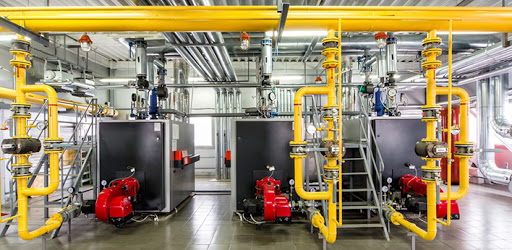A thermal oil boiler fires through a helical coil and generates energy from the hot products of combustion. This, by heating the coil through radiation and convection.
The coil heats the thermal oil or fluid that is pumped through the thermal oil boiler. The thermal oil heats coils in various types of heat users. Unlike a water or steam boiler, this heating process does not heavily pressurize the system.
A thermal oil boiler is nearly always cheaper to operate and maintain than water boilers. High pressures required to operate water and steam boilers makes them far more hazardous than thermal oil boilers. Other noticeable advantages with thermal oil systems are the lack of corrosion, lime deposits and scale that are common with heated water or steam boilers thus raising the operating costs of a water boiler considerably. Also, thermal oil boilers do not require makeup water or efficiency draining steam traps.
With thermal oil systems, the user is given the capability of high-temperature operation (up to 600F with organic thermal oils and 800F with certain synthetics) at quite low pressures. Due to the low operating pressure and properties of thermal fluids, most heaters are built to ASME Section VIII, Div. 1. A licensed boiler operator is not typically required.
Many people around the world refer to these systems by different names. Thermal oil heater, thermal oil system, thermal oil boiler, thermal fluid heater, thermal fluid system, thermal oil boiler, thermic fluid heater, hot oil heater, hot oil system, and hot oil boiler. All of them refer to the same type of closed loop liquid phase heat transfer system. And many people use the terms thermal oil boiler or thermal fluid boiler even though most systems do not involve any type of vaporization.



Heat transfer fluids are typically circulated through a wood, gas, oil or electric heaters. The fluid is heated by direct contact with the heater element, pumped to the process heat user and returned back to the heating system. This is a continuous process and many plants operate continuously. Organic heat transfer fluids generally are stable if operated below their thermal stability limit (TSL) and not contaminated by agents from outside of the system. Occasionally, overheating and contamination occurs, causing the formation of carbon insolubles that deposit on system surfaces and foul heat transfer surfaces. Sedimentation of solids can cause pipes and valves on the system to get plugged. Fouling reduces overall heat transfer system efficiency, increases wear of dynamic seals and can even cause burnout or cracking of the heater surfaces.
Liquid Process Systems developed this high-temperature filtration system designed to continually remove these carbon solids from heat transfer fluid or thermal oil.